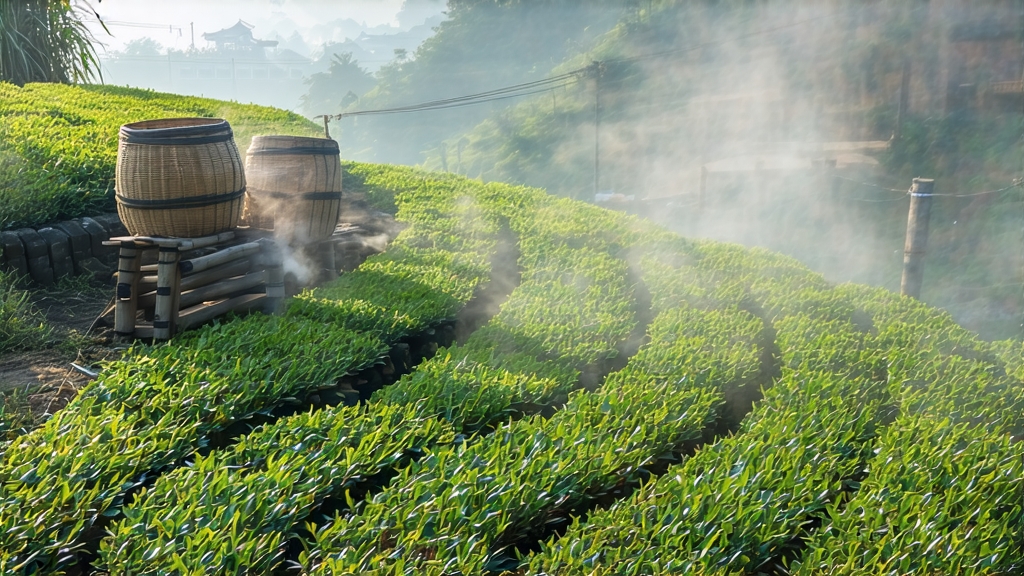
Tucked away in the humid, karst-pocked southwest of China, the small town of Liubao in Wuzhou, Guangxi, gave birth to a tea that once financed empires and still whispers of camphor, orchards and old leather. Liu Bao—literally “Six Forts”—is the least flamboyant yet most itinerant member of the dark-tea family. While Pu-erh hoards the limelight, Liu Bao spent three centuries riding the Tea-Horse Road into the highlands of Indochina, paying soldiers’ wages in Saigon and curing dysentery on Malay rubber plantations. Today the same tea is re-emerging from bamboo husks and century-old earthen jars to astonish a new generation of drinkers who crave depth without decadence.
History: From Frontier Currency to Maritime Ballast
The first written record appears in the 36-volume Gazetteer of Cangwu County (1863 edition): “Tea of Liupu [an earlier spelling] is pressed into square bricks, wrapped in bamboo leaves, loaded onto rafts and floated down the Yu River to Guangzhou, where foreign ships carry it to the Southern Seas.” By the late Qing, Liu Bao functioned as hard currency among Yao and Zhuang hill tribes; one bamboo-bound basket could ransom a mule or buy a month’s salt. When the British planted rubber in Malaya, they imported Liu Bao because its microbial profile prevented water-borne disease in the coolie camps. The tea’s fortunes dipped during the Cultural Revolution, when “old stuff” was suspect, but the 2003 SARS epidemic revived demand in Hong Kong pharmacies; suddenly every warehouse wanted the “black medicine” again.
Micro-Terroirs within One Town
Purists divide Liu Bao into three micro-zones separated by a single mountain ridge. The eastern group of villages—Tangping, Xianren, and Dutou—sit on red sandy loam rich in iron oxide; their tea is brisk, with a pronounced betel-nut bite. The western flank—Heishi, Yaoshan, and Liumian—lies in mist-shrouded shale valleys; leaf there accumulates more amino acids, yielding a velvety, orchid-like sweetness. Finally, the tiny southern enclave of Dafu, surrounded by wild camphor forests, produces the most coveted “camphor-nose” Liu Bao, whose liquor carries a cool, almost menthol echo. In the 1980s state farms planted the hardy Yuncha #1 cultivar at lower elevations to boost volume, but connoisseurs still chase seed-propagated “group cultivar” bushes 2–3 meters tall, many over a century old.
Craft: The Secret of Double Fermentation
Unlike Pu-erh’s piling that lasts 40–60 days, Liu Bao undergoes a shorter “primary pile” of 18–24 hours at 55 °C, just enough to awaken Eurotium cristatum—the same golden mold that flecks Fu bricks. The real magic happens after the tea is steamed and pressed into 40 kg bamboo baskets lined with banana leaves. These baskets are stacked in riverside warehouses where humidity hovers at 85 %. There the tea “rests” for a minimum of three years, undergoing a slow secondary fermentation akin to vintage Madeira. Master Chen Shigui, 72, describes the moment of readiness: “When you hear a cricket-like rustle inside the basket at midnight, the molds have finished their conversation.” Modern factories shorten the cycle to six months using climate-controlled rooms, but the traditional bamboo-basket version commands five times the price at auction in Kuala Lumpur.
The Grades: From Broken “Gong Cuo” to Needle-thin “Te Ji”
Liu Bao is graded not by leaf size alone but by the ratio of tip to stalk and the tightness of twist. Gong Cuo (“tribute broken”) consists of 2–3 mm particles intended for boiling in copper kettles on Hainan fishing junks. Yi Ji (“grade one”) keeps 30 % golden tips and steeps into a malty cocoa note perfect for Hong Kong-style milk tea. Te Ji (“special grade”) is 95 % unbroken buds, charcoal-twisted into glossy threads that smell of dried longan. The rarest tier, Hua Cha (“flower tea”), is not scented but naturally perfumed